Financial Management Report: An Analysis of Key Financial Concepts
VerifiedAdded on 2021/02/20
|7
|1793
|22
Report
AI Summary
This report provides a detailed overview of financial management, covering key concepts essential for business success. It begins by defining financial management as a systematic process of planning, controlling, and managing financial resources. The report then delves into specific areas, including liquidity, which is defined as the ability to convert assets into cash, and its importance in meeting short-term obligations and maintaining a company's goodwill. It also explores operating profit, calculated by deducting operational expenditures from gross profit, and its significance in assessing a company's efficiency and financial health. Furthermore, the report examines financing of assets, the process of using assets to secure loans, and its benefits and potential drawbacks. Finally, it discusses return on investment (ROI), a measure of investment efficiency, and its role in evaluating profitability and making informed investment decisions. The report concludes by summarizing the importance of these financial concepts and their impact on a company's financial performance and growth, referencing various academic sources to support its analysis.

FINANCIAL
MANAGEMENT
MANAGEMENT
Paraphrase This Document
Need a fresh take? Get an instant paraphrase of this document with our AI Paraphraser
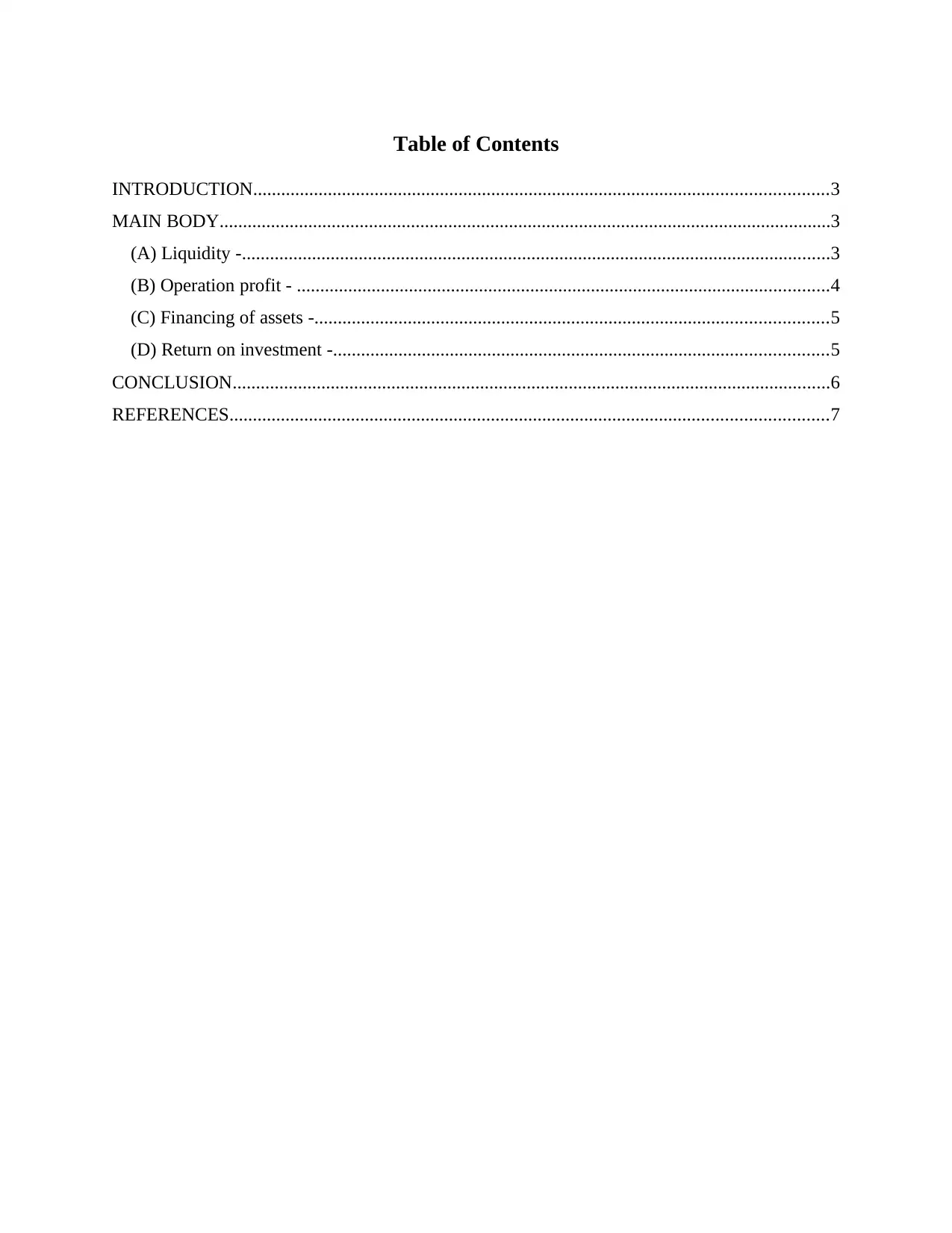
Table of Contents
INTRODUCTION...........................................................................................................................3
MAIN BODY...................................................................................................................................3
(A) Liquidity -..............................................................................................................................3
(B) Operation profit - ..................................................................................................................4
(C) Financing of assets -..............................................................................................................5
(D) Return on investment -..........................................................................................................5
CONCLUSION................................................................................................................................6
REFERENCES................................................................................................................................7
INTRODUCTION...........................................................................................................................3
MAIN BODY...................................................................................................................................3
(A) Liquidity -..............................................................................................................................3
(B) Operation profit - ..................................................................................................................4
(C) Financing of assets -..............................................................................................................5
(D) Return on investment -..........................................................................................................5
CONCLUSION................................................................................................................................6
REFERENCES................................................................................................................................7
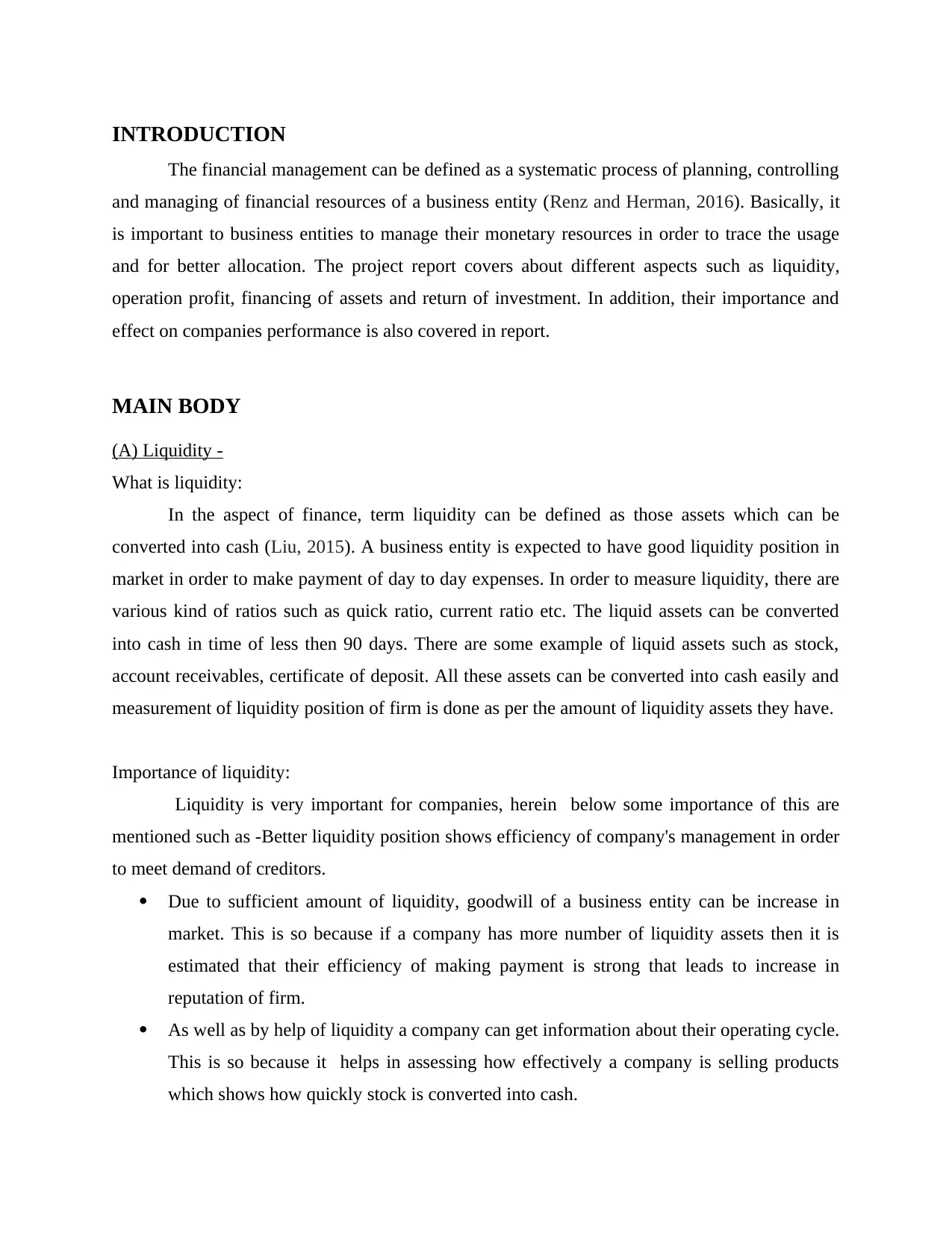
INTRODUCTION
The financial management can be defined as a systematic process of planning, controlling
and managing of financial resources of a business entity (Renz and Herman, 2016). Basically, it
is important to business entities to manage their monetary resources in order to trace the usage
and for better allocation. The project report covers about different aspects such as liquidity,
operation profit, financing of assets and return of investment. In addition, their importance and
effect on companies performance is also covered in report.
MAIN BODY
(A) Liquidity -
What is liquidity:
In the aspect of finance, term liquidity can be defined as those assets which can be
converted into cash (Liu, 2015). A business entity is expected to have good liquidity position in
market in order to make payment of day to day expenses. In order to measure liquidity, there are
various kind of ratios such as quick ratio, current ratio etc. The liquid assets can be converted
into cash in time of less then 90 days. There are some example of liquid assets such as stock,
account receivables, certificate of deposit. All these assets can be converted into cash easily and
measurement of liquidity position of firm is done as per the amount of liquidity assets they have.
Importance of liquidity:
Liquidity is very important for companies, herein below some importance of this are
mentioned such as -Better liquidity position shows efficiency of company's management in order
to meet demand of creditors.
Due to sufficient amount of liquidity, goodwill of a business entity can be increase in
market. This is so because if a company has more number of liquidity assets then it is
estimated that their efficiency of making payment is strong that leads to increase in
reputation of firm.
As well as by help of liquidity a company can get information about their operating cycle.
This is so because it helps in assessing how effectively a company is selling products
which shows how quickly stock is converted into cash.
The financial management can be defined as a systematic process of planning, controlling
and managing of financial resources of a business entity (Renz and Herman, 2016). Basically, it
is important to business entities to manage their monetary resources in order to trace the usage
and for better allocation. The project report covers about different aspects such as liquidity,
operation profit, financing of assets and return of investment. In addition, their importance and
effect on companies performance is also covered in report.
MAIN BODY
(A) Liquidity -
What is liquidity:
In the aspect of finance, term liquidity can be defined as those assets which can be
converted into cash (Liu, 2015). A business entity is expected to have good liquidity position in
market in order to make payment of day to day expenses. In order to measure liquidity, there are
various kind of ratios such as quick ratio, current ratio etc. The liquid assets can be converted
into cash in time of less then 90 days. There are some example of liquid assets such as stock,
account receivables, certificate of deposit. All these assets can be converted into cash easily and
measurement of liquidity position of firm is done as per the amount of liquidity assets they have.
Importance of liquidity:
Liquidity is very important for companies, herein below some importance of this are
mentioned such as -Better liquidity position shows efficiency of company's management in order
to meet demand of creditors.
Due to sufficient amount of liquidity, goodwill of a business entity can be increase in
market. This is so because if a company has more number of liquidity assets then it is
estimated that their efficiency of making payment is strong that leads to increase in
reputation of firm.
As well as by help of liquidity a company can get information about their operating cycle.
This is so because it helps in assessing how effectively a company is selling products
which shows how quickly stock is converted into cash.
⊘ This is a preview!⊘
Do you want full access?
Subscribe today to unlock all pages.

Trusted by 1+ million students worldwide
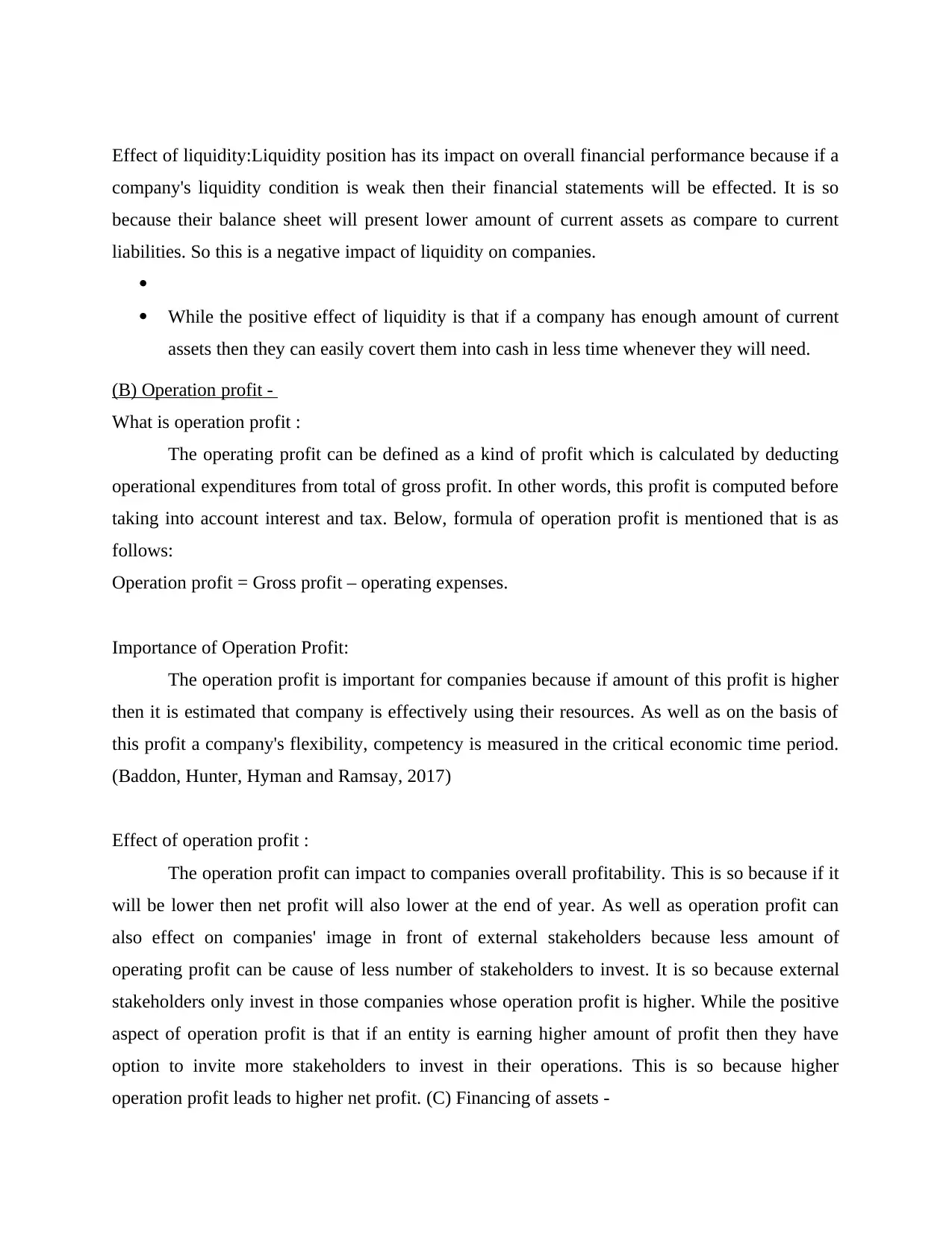
Effect of liquidity:Liquidity position has its impact on overall financial performance because if a
company's liquidity condition is weak then their financial statements will be effected. It is so
because their balance sheet will present lower amount of current assets as compare to current
liabilities. So this is a negative impact of liquidity on companies.
While the positive effect of liquidity is that if a company has enough amount of current
assets then they can easily covert them into cash in less time whenever they will need.
(B) Operation profit -
What is operation profit :
The operating profit can be defined as a kind of profit which is calculated by deducting
operational expenditures from total of gross profit. In other words, this profit is computed before
taking into account interest and tax. Below, formula of operation profit is mentioned that is as
follows:
Operation profit = Gross profit – operating expenses.
Importance of Operation Profit:
The operation profit is important for companies because if amount of this profit is higher
then it is estimated that company is effectively using their resources. As well as on the basis of
this profit a company's flexibility, competency is measured in the critical economic time period.
(Baddon, Hunter, Hyman and Ramsay, 2017)
Effect of operation profit :
The operation profit can impact to companies overall profitability. This is so because if it
will be lower then net profit will also lower at the end of year. As well as operation profit can
also effect on companies' image in front of external stakeholders because less amount of
operating profit can be cause of less number of stakeholders to invest. It is so because external
stakeholders only invest in those companies whose operation profit is higher. While the positive
aspect of operation profit is that if an entity is earning higher amount of profit then they have
option to invite more stakeholders to invest in their operations. This is so because higher
operation profit leads to higher net profit. (C) Financing of assets -
company's liquidity condition is weak then their financial statements will be effected. It is so
because their balance sheet will present lower amount of current assets as compare to current
liabilities. So this is a negative impact of liquidity on companies.
While the positive effect of liquidity is that if a company has enough amount of current
assets then they can easily covert them into cash in less time whenever they will need.
(B) Operation profit -
What is operation profit :
The operating profit can be defined as a kind of profit which is calculated by deducting
operational expenditures from total of gross profit. In other words, this profit is computed before
taking into account interest and tax. Below, formula of operation profit is mentioned that is as
follows:
Operation profit = Gross profit – operating expenses.
Importance of Operation Profit:
The operation profit is important for companies because if amount of this profit is higher
then it is estimated that company is effectively using their resources. As well as on the basis of
this profit a company's flexibility, competency is measured in the critical economic time period.
(Baddon, Hunter, Hyman and Ramsay, 2017)
Effect of operation profit :
The operation profit can impact to companies overall profitability. This is so because if it
will be lower then net profit will also lower at the end of year. As well as operation profit can
also effect on companies' image in front of external stakeholders because less amount of
operating profit can be cause of less number of stakeholders to invest. It is so because external
stakeholders only invest in those companies whose operation profit is higher. While the positive
aspect of operation profit is that if an entity is earning higher amount of profit then they have
option to invite more stakeholders to invest in their operations. This is so because higher
operation profit leads to higher net profit. (C) Financing of assets -
Paraphrase This Document
Need a fresh take? Get an instant paraphrase of this document with our AI Paraphraser
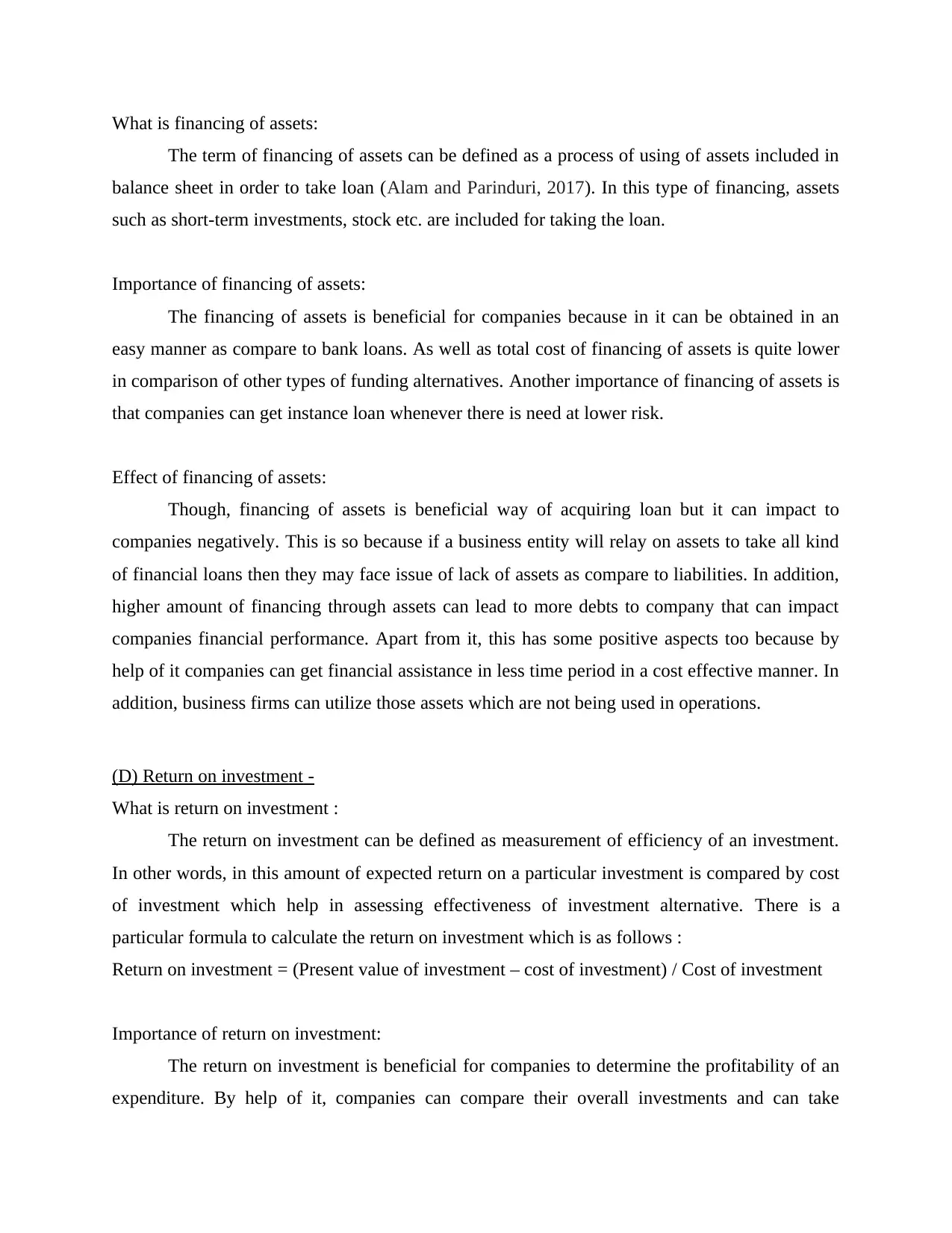
What is financing of assets:
The term of financing of assets can be defined as a process of using of assets included in
balance sheet in order to take loan (Alam and Parinduri, 2017). In this type of financing, assets
such as short-term investments, stock etc. are included for taking the loan.
Importance of financing of assets:
The financing of assets is beneficial for companies because in it can be obtained in an
easy manner as compare to bank loans. As well as total cost of financing of assets is quite lower
in comparison of other types of funding alternatives. Another importance of financing of assets is
that companies can get instance loan whenever there is need at lower risk.
Effect of financing of assets:
Though, financing of assets is beneficial way of acquiring loan but it can impact to
companies negatively. This is so because if a business entity will relay on assets to take all kind
of financial loans then they may face issue of lack of assets as compare to liabilities. In addition,
higher amount of financing through assets can lead to more debts to company that can impact
companies financial performance. Apart from it, this has some positive aspects too because by
help of it companies can get financial assistance in less time period in a cost effective manner. In
addition, business firms can utilize those assets which are not being used in operations.
(D) Return on investment -
What is return on investment :
The return on investment can be defined as measurement of efficiency of an investment.
In other words, in this amount of expected return on a particular investment is compared by cost
of investment which help in assessing effectiveness of investment alternative. There is a
particular formula to calculate the return on investment which is as follows :
Return on investment = (Present value of investment – cost of investment) / Cost of investment
Importance of return on investment:
The return on investment is beneficial for companies to determine the profitability of an
expenditure. By help of it, companies can compare their overall investments and can take
The term of financing of assets can be defined as a process of using of assets included in
balance sheet in order to take loan (Alam and Parinduri, 2017). In this type of financing, assets
such as short-term investments, stock etc. are included for taking the loan.
Importance of financing of assets:
The financing of assets is beneficial for companies because in it can be obtained in an
easy manner as compare to bank loans. As well as total cost of financing of assets is quite lower
in comparison of other types of funding alternatives. Another importance of financing of assets is
that companies can get instance loan whenever there is need at lower risk.
Effect of financing of assets:
Though, financing of assets is beneficial way of acquiring loan but it can impact to
companies negatively. This is so because if a business entity will relay on assets to take all kind
of financial loans then they may face issue of lack of assets as compare to liabilities. In addition,
higher amount of financing through assets can lead to more debts to company that can impact
companies financial performance. Apart from it, this has some positive aspects too because by
help of it companies can get financial assistance in less time period in a cost effective manner. In
addition, business firms can utilize those assets which are not being used in operations.
(D) Return on investment -
What is return on investment :
The return on investment can be defined as measurement of efficiency of an investment.
In other words, in this amount of expected return on a particular investment is compared by cost
of investment which help in assessing effectiveness of investment alternative. There is a
particular formula to calculate the return on investment which is as follows :
Return on investment = (Present value of investment – cost of investment) / Cost of investment
Importance of return on investment:
The return on investment is beneficial for companies to determine the profitability of an
expenditure. By help of it, companies can compare their overall investments and can take
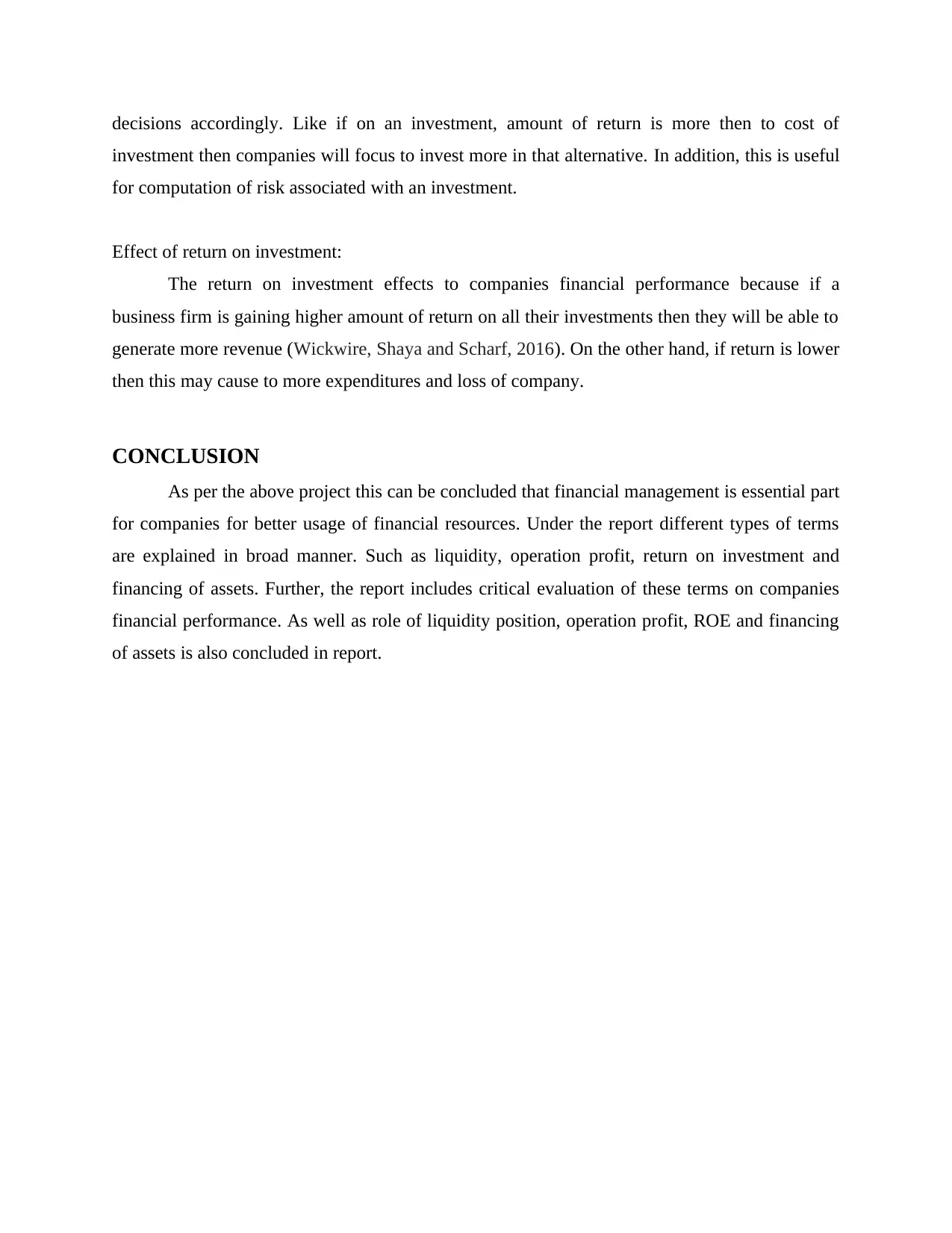
decisions accordingly. Like if on an investment, amount of return is more then to cost of
investment then companies will focus to invest more in that alternative. In addition, this is useful
for computation of risk associated with an investment.
Effect of return on investment:
The return on investment effects to companies financial performance because if a
business firm is gaining higher amount of return on all their investments then they will be able to
generate more revenue (Wickwire, Shaya and Scharf, 2016). On the other hand, if return is lower
then this may cause to more expenditures and loss of company.
CONCLUSION
As per the above project this can be concluded that financial management is essential part
for companies for better usage of financial resources. Under the report different types of terms
are explained in broad manner. Such as liquidity, operation profit, return on investment and
financing of assets. Further, the report includes critical evaluation of these terms on companies
financial performance. As well as role of liquidity position, operation profit, ROE and financing
of assets is also concluded in report.
investment then companies will focus to invest more in that alternative. In addition, this is useful
for computation of risk associated with an investment.
Effect of return on investment:
The return on investment effects to companies financial performance because if a
business firm is gaining higher amount of return on all their investments then they will be able to
generate more revenue (Wickwire, Shaya and Scharf, 2016). On the other hand, if return is lower
then this may cause to more expenditures and loss of company.
CONCLUSION
As per the above project this can be concluded that financial management is essential part
for companies for better usage of financial resources. Under the report different types of terms
are explained in broad manner. Such as liquidity, operation profit, return on investment and
financing of assets. Further, the report includes critical evaluation of these terms on companies
financial performance. As well as role of liquidity position, operation profit, ROE and financing
of assets is also concluded in report.
⊘ This is a preview!⊘
Do you want full access?
Subscribe today to unlock all pages.

Trusted by 1+ million students worldwide
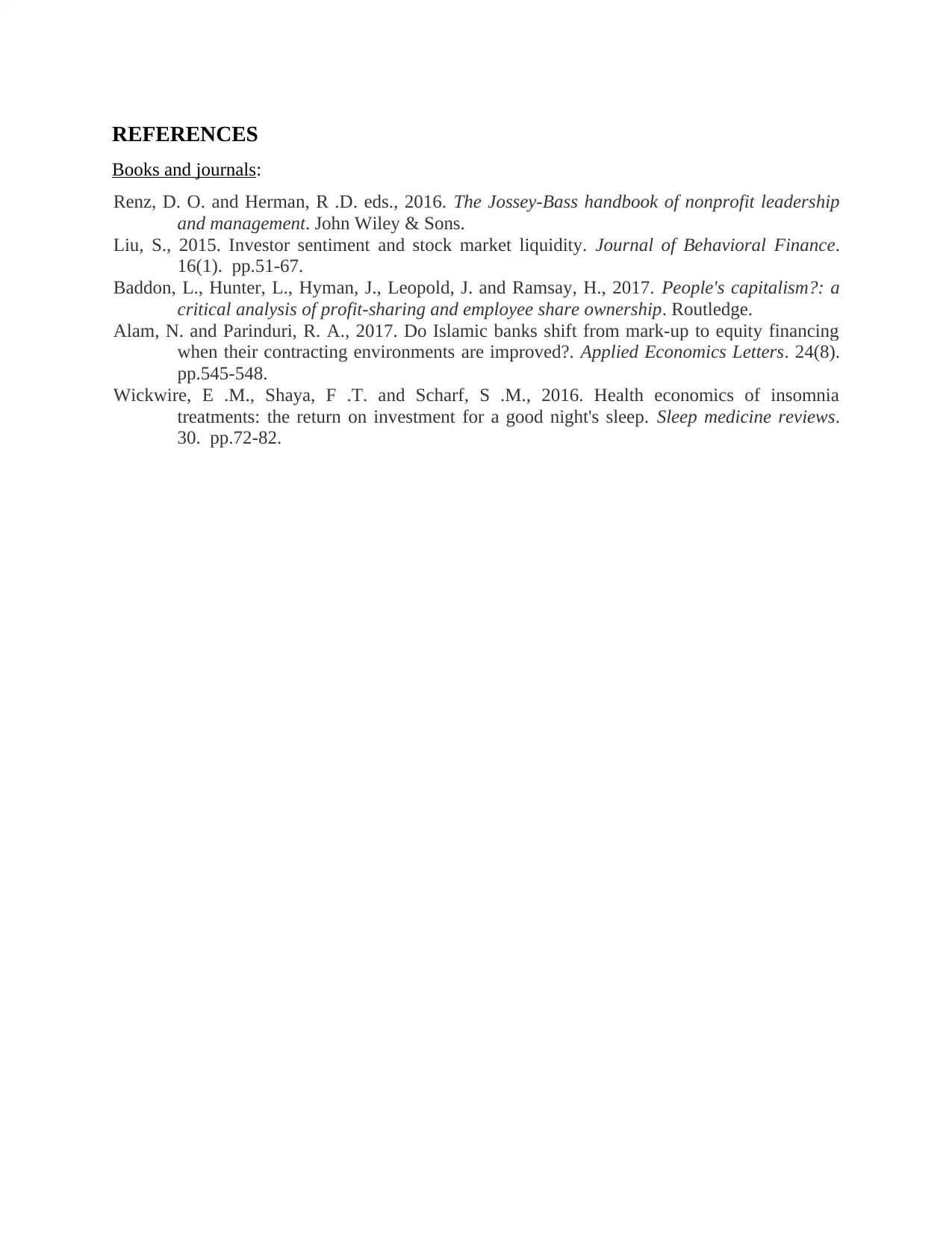
REFERENCES
Books and journals:
Renz, D. O. and Herman, R .D. eds., 2016. The Jossey-Bass handbook of nonprofit leadership
and management. John Wiley & Sons.
Liu, S., 2015. Investor sentiment and stock market liquidity. Journal of Behavioral Finance.
16(1). pp.51-67.
Baddon, L., Hunter, L., Hyman, J., Leopold, J. and Ramsay, H., 2017. People's capitalism?: a
critical analysis of profit-sharing and employee share ownership. Routledge.
Alam, N. and Parinduri, R. A., 2017. Do Islamic banks shift from mark-up to equity financing
when their contracting environments are improved?. Applied Economics Letters. 24(8).
pp.545-548.
Wickwire, E .M., Shaya, F .T. and Scharf, S .M., 2016. Health economics of insomnia
treatments: the return on investment for a good night's sleep. Sleep medicine reviews.
30. pp.72-82.
Books and journals:
Renz, D. O. and Herman, R .D. eds., 2016. The Jossey-Bass handbook of nonprofit leadership
and management. John Wiley & Sons.
Liu, S., 2015. Investor sentiment and stock market liquidity. Journal of Behavioral Finance.
16(1). pp.51-67.
Baddon, L., Hunter, L., Hyman, J., Leopold, J. and Ramsay, H., 2017. People's capitalism?: a
critical analysis of profit-sharing and employee share ownership. Routledge.
Alam, N. and Parinduri, R. A., 2017. Do Islamic banks shift from mark-up to equity financing
when their contracting environments are improved?. Applied Economics Letters. 24(8).
pp.545-548.
Wickwire, E .M., Shaya, F .T. and Scharf, S .M., 2016. Health economics of insomnia
treatments: the return on investment for a good night's sleep. Sleep medicine reviews.
30. pp.72-82.
1 out of 7
Related Documents
Your All-in-One AI-Powered Toolkit for Academic Success.
+13062052269
info@desklib.com
Available 24*7 on WhatsApp / Email
![[object Object]](/_next/static/media/star-bottom.7253800d.svg)
Unlock your academic potential
Copyright © 2020–2025 A2Z Services. All Rights Reserved. Developed and managed by ZUCOL.





